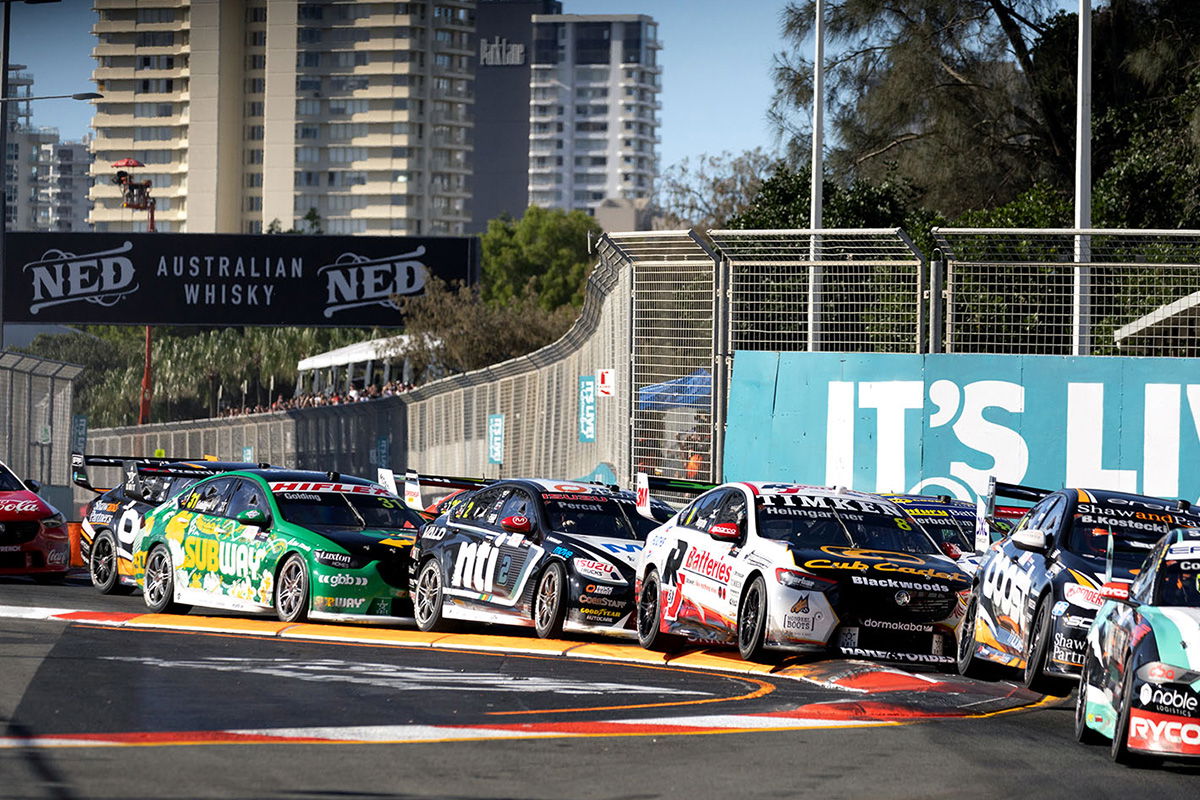

Kerb strikes and tyre bundles were a major talking point over the Gold Coast weekend as Supercars returned to the streets of Surfers Paradise.
Following practice on Friday, drivers voiced confusion over what they claimed was inconsistency in the track’s kerb sensor system after a spate of kerb strikes up and down the field.
In short, a kerb strike deems that a car has left the bounds of the race track, rendering any lap in question invalid.
Track limits are defined by a yellow/white line, while the kerbs are policed by an advanced electronic system, ensuring accuracy and fair game.
That is backed up by a visual deterrent in the form of tyre bundles in key locations.
A petition was signed by every driver on the Repco Supercars Championship grid to rectify the perceived kerb strike issue early in the weekend.
The efforts were led by a four-pronged group of Shane van Gisbergen, Will Davison, Cameron Waters, and Chaz Mostert.
Some team owners were not even aware their drivers had signed the form, before a mid-event meeting with Supercars resulted in no major changes, which left van Gisbergen frustrated.
It later came to light that the tyre bundle on driver’s left entering the first chicane was moved, “Back about 400 millimetres”, though that was the only outcome.
Despite the modest action, Mostert did praise the fact that Supercars and the Motorsport Australia Race Director and Deputy Race Directors listened, saying that, “In previous years I don’t think there would even have been a possibility to sit with them”.
The primary solution put forward by drivers was to turn off the electronic sensors and remove what they described as the ‘lottery’ element, but keep the tyre bundles in place.
However, criticism then shifted to said tyre bundles on Sunday, though that topic delivered split opinions, with some drivers in support.
Race 32’s mammoth pile-up, which claimed six cars, was kickstarted by James Golding collecting a tyre bundle in the beach chicane which was collected by Thomas Randle.
It sent Golding spinning into the barriers and left several others unable to avoid the carnage.
The PremiAir Racing driver told Speedcafe.com post-race he is, “Not going to go and blame [tyre bundles] as the reason it all happened. I did make a mistake.”
But the likes of James Courtney and Nick Percat thought otherwise, with the latter stating, “I think in this day and age we’re a bit over tyre bundles”.
As Motorsport Australia Race Director, James Taylor, explained, kerb sensors and tyre bundles complement each other.
“The tyre bundles are a part of multiple facets to what we use for [track limits] restriction,” Taylor told Speedcafe.com.
“They can be placed in chicanes to aid in sighting the apex and to also assist in preventing people just straight-lining the chicanes.
“Then also to police that we’ve also got the timing loop [kerb sensor].
“So the tyre bundles are just one component of something that’s put in place to ensure that people use the circuit as a circuit has been defined, and that’s the way they’ve been put in there.
“[The tyre bundle] gives you more of a visual perspective to where it is, instead of just putting a chicane with no markings.
“It’s just one part of a component that helps us control track limits.”

The purpose centres around ensuring the circuit meets the licensing requirements, especially in the case of a street venue.
All race tracks need to meet the minimum of FIA Grade 3 to host Supercars.
Speeds in some areas have to be controlled due to lack of run-off or sufficient space.
Motorsport Australia is accountable for the safety of every driver, marshal, and spectator, with tyre bundles and kerb sensors designed to keep speeds at the licensed level in particular zones.
“In Supercars, all our circuits have to meet an FIA requirement on a certain level,” added Taylor.
“Every venue, to get the licence, runs through computer simulation modes, and that’s why you put chicanes or apexes where they are, to meet the requirement for that licencing structure.
“Street circuits don’t allow you for extensive run-offs, so speed mitigation measures like chicanes might be added to ensure adequate run-off lengths can be achieved. You have to do what you can to minimise the speeds going through certain sections of the circuit.
“It’s really just there as an added component of safety trying to reduce the speed factor a bit, so it complies with the FIA requirements.”
During practice and qualifying, teams can see whether one of its drivers has committed a kerb strike on any given lap, however, that access is restricted for the race.
This is intended to allow race control to police it and remove any potential abuse where an entry may save its kerb strikes and then use all of them at once to gain a particular sporting advantage.
Per information cited to Speedcafe.com, Macauley Jones and van Gisbergen were the two cleanest drivers in regards to kerb hops.
























Discussion about this post